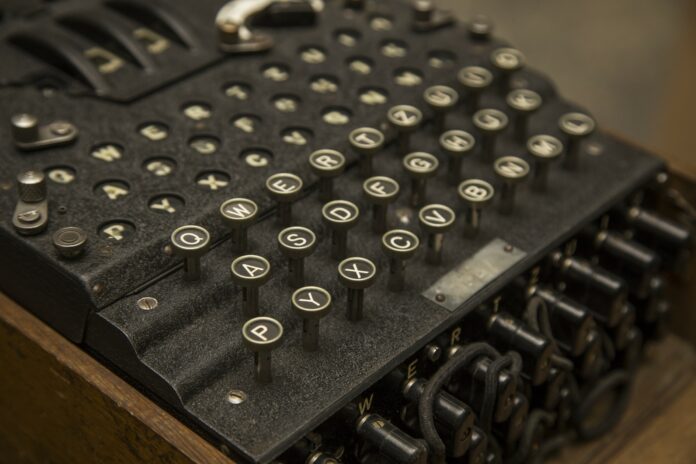Information security might seem modern, but people have always needed to keep sensitive information from falling into the wrong hands. Cryptography has always been essential in this area. Those who have the information encrypt it to control who can read it, while those who want the info find new ways to break the code.
The beginnings of cryptography
Cryptography has been around for a long time. Egyptian tombs were decorated with complicated hieroglyphics as early as 2,000 BC. This wasn’t so much to hide the meaning as to make the dead nobles seem more mysterious. There is also evidence that the Mesopotamians encrypted cuneiform text to hide information. In the 5th century BC, the Hebrews used simple ciphers, like using the last letter of the alphabet for the first letter, the second-to-last letter for the third letter, and so on.
During the same period, the Spartans devised a clever way to send messages. They wrote on thin papyrus sheets and wrapped them around a stick called a “scytale.” The message would be encrypted when the sheet was taken off the scytale. The news could only be reread when the sheet was wrapped around a scytale with the same diameter. This made it safe for the Spartans to send and get secret military plans.
Over time, people’s ways of doing things got better. In the second century BC, the Greek scholar Polybius put the alphabet into a five-by-five squares grid. He then said that torches or hand signals should be used to send encrypted messages, coordinate by coordinate. Julius Caesar made his cipher by moving each letter in a message two spots further down the alphabet.
It was easy to make codes but hard to break them. Al-Kindi, an Arab polymath living in the 9th century AD, was the first to use scientific methods to study and break encryption. He did this by looking at how often letters are used in a language to crack the code. Ibn al-Durayhim, who worked in the 13th century, was influenced by his work. Ibn al-Durayhim wrote detailed descriptions of new systems that used more complicated letter-for-letter substitutions. These systems would be much harder to break.
Cryptography in power
Different Italian city-states fought for power in the 15th century, making Italy one of the most exciting times in history. Cryptography was used a lot in Rome, Florence, and Milan courts. For example, Venice had secretaries trained to encrypt and decrypt messages going to and from the Doge. The ways of doing things got better all over Europe. Leon Battista Alberti, a Florentine born in Genoa and moved to Florence, devised a way to write the alphabet on two copper discs. In 1518, a German monk named Trimethius created a complicated cryptographic table called the Tabula Recta. An Italian cryptographer named Giovan Battista Bellaso and then a French diplomat named Balise de Vigenere added it. The following 400 years of cryptography were based on these tables.
By the 17th century, cryptography was essential to the whole country. Henri, Prince of Conde, attacked the Huguenot city of Realmont in Southern France in 1628. A local mathematician, Antoine Rossignol, got a message from the besieged city in code and figured out what it said. This showed that the Huguenots were out of ammunition. The next thing that happened was that Rossignol gave up. This caught the attention of Cardinal Richelieu, who then put Rossignol to work for Louis XIV.
Rossignol and his son made a new code called the Grand Cipher and ran an agency called the Cabinet Noir to break codes. Within a few decades, every European court had to have the so-called “Black Chamber.”
Cryptography at war
Cryptography was an essential tool during the Napoleonic Wars, which took place from 1803 to 1815. Napoleon was embarrassed by the number of messages being read by British forces, so he asked the French army to make a new code that could not be broken. This code was called the Army of Portugal Code. In use by the spring of 1811, the code was broken in November by an English officer named Major George Scovell, who only had a book on cryptography and a few captured messages to help him.
He did this in just two days. Early in 1812, the French made a new code called the Great Paris Cipher. It had more than 1,400 numbers that could be used instead of words or parts of words in millions of different ways. The work that Scovell did gave Wellington a tactical edge. Now, it was up to the major to break the new code.
He did it in about a year. The cipher may have seemed impossible to crack, but the French officers who used it got lazy and only encrypted parts of the message, leaving other parts in plain text. Scovell then figured out what some of the encrypted words were. The more messages he got, the more of the cipher he broke. By July, the British had broken enough of the cipher to read a message from the French commander in Spain about reinforcements. This let Wellington win the battle at Salamanca before the reinforcements arrived. After that, Wellington could plan the Iberian campaign with almost complete knowledge of what the French were doing. This let him drive Napoleon’s armies across northern Spain and into defeat.
Cryptography in the Machine Age
In the 1830s, when the telegraph was invented, it changed the way businesses and the military talked to each other. With the invention of the radio in 1894, people could talk to each other wirelessly in real-time. Even though telegraph and radio communications became necessary for diplomacy, espionage, and war, encryption, and decryption were still done by hand or with simple rotor-based devices like the 1785 Jefferson Wheel. A system with 26 wheels threaded on an iron spindle that could be put back together daily in any order was the primary US encryption method for about 150 years.
But when the First World War ended, cryptography moved into the age of machines.
In 1915, two Dutch naval officers made a system with a motorized rotor. By 1919, Huge Hebern in the US, Hugo Koch in Holland, and Arthur Scherbius in Germany had all shown similar systems. Scherbius showed his machine in Bern in 1923, and the German Navy and Army used it in 1926 and 1928. It was called “Enigma” by Scherbius.
During the First World War, cryptography was essential. The work of the British Admiralty’s Room 40 code-breaking office led directly to the battles of Jutland and Dogger Bank. In addition, the decryption of a German diplomat’s telegram led to the United States joining the war. During the Second World War, though, it became essential. Germany’s U-boats were always a threat to Britain’s Atlantic convoys because it was cut off from the rest of Europe, controlled by Nazis. The U-Boats worked alone, but when they found a convoy, they used radio to contact other U-Boats and plan coordinated attacks. The German Navy’s Enigma machines encrypted these messages, so it became a matter of life and death to figure out how to break Enigma.

Mario Rejewski in Poland had broken the German Army’s Enigma code in 1938, and the Polish gave the Germans their knowledge and Bomba decoding machines just before the German invasion. But the Army’s Enigma machines only used three of five rotors to encrypt and decrypt messages for the day. The Navy’s, on the other hand, used three of eight. Also, the Navy had more complicated ways to set up message keys, including a list of the first positions of the rotors at the start of encryption.
Alan Turing and Gordon Weichman worked hard on the Polish Bomba at Bletchley Park in England. Then, finally, they made a new version: a code-breaking machine that could figure out the set of rotors used for a day and their positions from a crib, a section of plain text thought to match the intercepted ciphertext. While this was happening, Turing, Max Newman, and Tommy Flowers made Colossus, the world’s first programmable electronic digital computer, and used it to break the German High Command’s complicated codes. Together, Turing’s Bombe and Colossus changed the course of the war, cutting it short by many months and saving the lives of many thousands of people.
Cryptography meets the Computer Age
The computer and use of computers to store private information made cryptography more difficult. Computing made it easier for businesses to store, protect, and analyze data but also gave hackers new ways to break codes. Communication Theory of Secrecy Systems, a paper by Claude Shannon in 1949, established a fundamental theory for math-based cryptography in the computer age. In 1976, Whitfield Diffie and Marti Hellman developed the public key and asymmetric key encryption ideas. This idea was revolutionary: a system that didn’t use just one key to encrypt and decrypt, but two pairs of mathematically related keys, each of which could decrypt messages encrypted by the other. Their work led to the RSA cryptosystem, which is still used in most encryption systems today.
Governments asked for higher levels of safety. IBM and the NSA worked together in 1979 to develop the Data Encryption Standard (DES), a 56-bit encryption standard so advanced that not even supercomputers could break it. This was the US government standard for almost 20 years until the new Advanced Encryption Standard took place in 1997. (AES). In its weakest form, with only 128 bits, AES would have taken computers of the time 255 years to break.
We no longer think about these things. Businesses that buy new HP laptops and desktop PCs can protect their data with Windows 10 Professional’s built-in Bitlocker encryption. This uses AES and a key embedded in the system’s Trusted Platform Module chip to lock down the data on the hard disk. That’s level of safety that governments fifty years ago could never have imagined. The Atalia Network Security Processors from HP give some of the biggest companies in the world peace of mind that their data is safe, which is a must when dealing with sensitive financial information. Even though computers are getting more powerful all the time, which makes security threats more dangerous, our encryption technologies are still robust. We’ve come a long way from hieroglyphics and the Spartan scytale, but we keep information safe.

